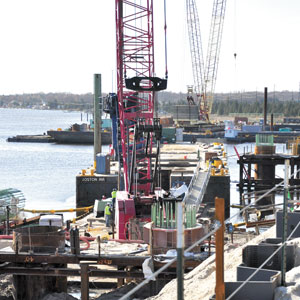Drilling Fluids: Pick the Right Slurry for Marine Foundations Projects
There are many different methods for installing drilled shafts, including: conventional auger drilling, slurry displaced drilled shafts, oscillation and reverse circulation, just to name a few. Every project presents its own set of challenges, which may preclude or require a certain method of installation. While means and methods are typically left up to the contactor to decide, often the site and soil conditions determine the most cost effective solution. For this reason, slurry displaced shafts have become an extremely popular method for drilled shaft construction in a wide range of soil and siteconditions.
The most common mistake contactors make in slurry displaced drilled shafts is assuming that all slurries are the same. In fact, each type of slurry is defined by a unique chemical formula and characteristics. There are minerals slurries, synthetic polymer slurries, natural slurries and enough additives to make your head spin. So, how do you choose the right one for your application? The answer is simple. Consulting with your slurry provider prior to the bidding process will ensure that you are getting the correct product for the job. This is especially true if you have adverse soil or groundwater conditions.

|
|
Installation methods for drilled shafts vary depending on the on-site soil conditions and factors like the water table. Source: Cetco |
Marine foundations are no exception and can be particularly challenging for even the most experienced contractor. No matter what type of slurry suits your application, head pressure is an essential component in maintaining shaft integrity. When working in saline environments it is important to recognize that salt water weighs approximately three percent more than fresh water. This means that you need to increase the slurry head to compensate for the added difference. Your slurry provider should be able to calculate the appropriate amount of slurry head necessary based on the type of slurry, diameter, soil conditions and static water level for your project. In cases where static water is near the working grade, it may be necessary to extend the top casing to allow for the extra slurry volume. Extending the casing often times creates rig/tooling clearance issues, which may require elevating your working platform. Planning for these obstacles prior to your bid can save you a lot of time, money and headaches down the road.
In addition to requiring extra head pressure, salt-water environments also limit the types of slurry you can choose from. Bentonite, the most popular mineral slurry used in drilled shaft construction, will rapidly flocculate in the presence of salt water, making it a poor choice in a marine environments. But not all slurries are affected this way. Most synthetic polymer slurries, such as partially hydrolyzed polyacrylamide (PHPA) and vinyl polymers, work well in marine environments when pre-hydrated with fresh water. It is important to note that with most synthetic polymer slurries, salt-water dosing rates are significantly higher than those of fresh water and recycling can often be limited. Again, planning for these added costs during bid time will improve your overall product quality and profitability in the long run. Natural polymers, such as polyanionic cellulosic polymer (PAC) and guar gum, and modified natural polymers are some of the best performing products in marine environments. They are extremely salt water tolerant to the point that they can be mixed directly with salt water. To top it off, most are biodegradable, which can be important when working in environmentally sensitive areas. However, the downfall to natural and modified natural polymers is cost. On large projects, the cost of running these products can easily double that of a mineral or synthetic polymer slurry.
The last obstacle to overcome is tidal influence. Most marine environments are affected by some degree by tidal influence. It is important to know the tide schedule for your project and plan for the water elevation changes. As a rule of thumb, you always want to base your head pressure calculations over high tide. Making sure that your casing is seated securely in the formation is also important. This not only seals the slurry in the hole but also prevents the rushing water from possibly dislodging the casing.
Working with slurry in marine environments does not have to be a guessing game. By consulting your slurry provider and planning for the additional obstacles salt water introduces, you can reduce your risk and increase the chances of a successful, profitable project.
Looking for a reprint of this article?
From high-res PDFs to custom plaques, order your copy today!

